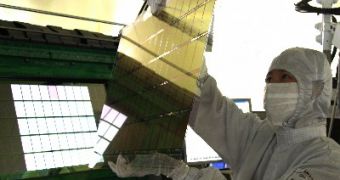Japanese company Matsushita Corporation, owner of the Panasonic brand, has reportedly announced that it is investing up to $370 million to build the sixth generation pilot and the 8.5 generation of OLED R&D manufacturing lines.
OLED seems to be taking ages to become mainstream technology, but despite the fact we’re still not there yet, we might see a significant drop in OLED panel price during the next year, as plasma master Panasonic is investing heavily in its OLED TV production line in Himeji, Japan.
OLED manufacturing currently requires the use of Low-Temperature Polysilicon backplanes and these LTPS backplanes require laser annealing from an amorphous silicon start.
Even Samsung, currently the most popular OLED screen maker, has spun off its entire display division, but kept the OLED R&D division because this one still needs huge amounts of investment money.
Having only one big OLED manufacturer is not the best market situation for the consumer, so Panasonic’s move will have a negative effect on the pricing of the OLED panels and a positive one on our wallets.
They are working with the largest suppliers of OLED materials like Japanese compatriot Mitsubishi Chemicals and American DuPont.
Panasonic’s recently announced Eluga phone is probably the company’s newest product to use the latest OLED technology Matsushita has, but they also regard the concept of OLED lighting as a great business opportunity.
More and more OLED panels will come to the market next year, but it isn't until 2015 when we’ll be able to say that OLED is dominating the smartphone and PC markets. OLED is short for Organic Light Emitting Diode and is considered as a cornerstone technology for development of display devices.
The development of technology started back in the 1950s, but the first organic diode was experimented in 1987, at Eastman Kodak’s labs.
Current OLED technology is available as AMOLED and OLED and powers very successful smartphones, such as Samsung Galaxy SII and its successor, Samsung Galaxy III.
While the OLED displays offer many advantages, there still are some significant disadvantages, such as a much shorter life span when compared with standard LCDs and a high manufacturing cost.

 14 DAY TRIAL //
14 DAY TRIAL //